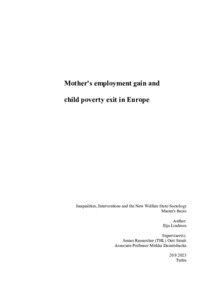Mother's employment gain and child poverty exit in Europe
Lindroos, Eija (2023-10-09)
Mother's employment gain and child poverty exit in Europe
Lindroos, Eija
(09.10.2023)
Julkaisu on tekijänoikeussäännösten alainen. Teosta voi lukea ja tulostaa henkilökohtaista käyttöä varten. Käyttö kaupallisiin tarkoituksiin on kielletty.
avoin
Julkaisun pysyvä osoite on:
https://urn.fi/URN:NBN:fi-fe20231103142990
https://urn.fi/URN:NBN:fi-fe20231103142990
Tiivistelmä
Working parents and especially maternal employment are thought to provide the best protection against child poverty. However, not all employment helps to avoid poverty (Crettaz, 2013). This study analyses the relationship between maternal transitions into employment and children’s likelihood of leaving poverty by utilizing pooled (2010-2017) longitudinal data from the EU-SILC, and a sample of 20,736 children from 30 European countries. The study uses linear regression analysis with individual fixed-effects to analyse the relationship between mother’s employment gain and children’s poverty exit, and how the type of employment, maternal characteristics, and the household- and the country-context may moderate the relationship.
Overall, mother’s transition into employment increased the likelihood of children leaving poverty by 15 percentage points. Entry into part-time employment increased the chances of child poverty exit but not as strongly as entry into full-time work. Moreover, children of low-educated mothers, and children in large families (3 or more children) or in households that have very young children (0- to 2-years-old) had a harder time leaving poverty when the mother gained employment. Cross-country variation in the probability of child poverty exit when the mother gained employment was considerable. In a context of high availability of formal full-time childcare for younger children or low female part-time employment rate, the relationship between mother’s employment gain and child poverty exit was more positive. The findings highlight the importance of mothers’ work quality and access to adequate childcare services for fighting child poverty, while supporting the household income of vulnerable children.
Overall, mother’s transition into employment increased the likelihood of children leaving poverty by 15 percentage points. Entry into part-time employment increased the chances of child poverty exit but not as strongly as entry into full-time work. Moreover, children of low-educated mothers, and children in large families (3 or more children) or in households that have very young children (0- to 2-years-old) had a harder time leaving poverty when the mother gained employment. Cross-country variation in the probability of child poverty exit when the mother gained employment was considerable. In a context of high availability of formal full-time childcare for younger children or low female part-time employment rate, the relationship between mother’s employment gain and child poverty exit was more positive. The findings highlight the importance of mothers’ work quality and access to adequate childcare services for fighting child poverty, while supporting the household income of vulnerable children.
